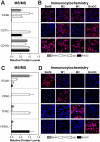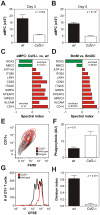Unique proteomic signatures distinguish macrophages and dendritic cells
- PMID: 22428014
- PMCID: PMC3299764
- DOI: 10.1371/journal.pone.0033297
Unique proteomic signatures distinguish macrophages and dendritic cells
Abstract
Monocytes differentiate into heterogeneous populations of tissue macrophages and dendritic cells (DCs) that regulate inflammation and immunity. Identifying specific populations of myeloid cells in vivo is problematic, however, because only a limited number of proteins have been used to assign cellular phenotype. Using mass spectrometry and bone marrow-derived cells, we provided a global view of the proteomes of M-CSF-derived macrophages, classically and alternatively activated macrophages, and GM-CSF-derived DCs. Remarkably, the expression levels of half the plasma membrane proteins differed significantly in the various populations of cells derived in vitro. Moreover, the membrane proteomes of macrophages and DCs were more distinct than those of classically and alternatively activated macrophages. Hierarchical cluster and dual statistical analyses demonstrated that each cell type exhibited a robust proteomic signature that was unique. To interrogate the phenotype of myeloid cells in vivo, we subjected elicited peritoneal macrophages harvested from wild-type and GM-CSF-deficient mice to mass spectrometric and functional analysis. Unexpectedly, we found that peritoneal macrophages exhibited many features of the DCs generated in vitro. These findings demonstrate that global analysis of the membrane proteome can help define immune cell phenotypes in vivo.
Conflict of interest statement
Figures






References
-
- Bogdan C, Nathan C. Modulation of macrophage function by transforming growth factor beta, interleukin-4, and interleukin-10. Ann N Y Acad Sci. 1993;685:713–739. - PubMed
-
- Gordon S, Taylor PR. Monocyte and macrophage heterogeneity. Nat Rev Immunol. 2005;5:953–964. - PubMed
-
- Hamilton JA. Colony-stimulating factors in inflammation and autoimmunity. Nat Rev Immunol. 2008;8:533–544. - PubMed
-
- Gordon S, Martinez FO. Alternative activation of macrophages: mechanism and functions. Immunity. 2010;32:593–604. - PubMed
Publication types
MeSH terms
Substances
Grants and funding
- HL075381/HL/NHLBI NIH HHS/United States
- HL030086/HL/NHLBI NIH HHS/United States
- P30 DK089507/DK/NIDDK NIH HHS/United States
- R01 HL062887/HL/NHLBI NIH HHS/United States
- HL097365/HL/NHLBI NIH HHS/United States
- R01 HL086798/HL/NHLBI NIH HHS/United States
- HL086798/HL/NHLBI NIH HHS/United States
- P01 HL092969/HL/NHLBI NIH HHS/United States
- R01 HL075381/HL/NHLBI NIH HHS/United States
- HL062887/HL/NHLBI NIH HHS/United States
- P30 DK017047/DK/NIDDK NIH HHS/United States
- P01 HL030086/HL/NHLBI NIH HHS/United States
- HL092969/HL/NHLBI NIH HHS/United States
- R01 HL097365/HL/NHLBI NIH HHS/United States
LinkOut - more resources
Full Text Sources
Other Literature Sources
Molecular Biology Databases
Research Materials

